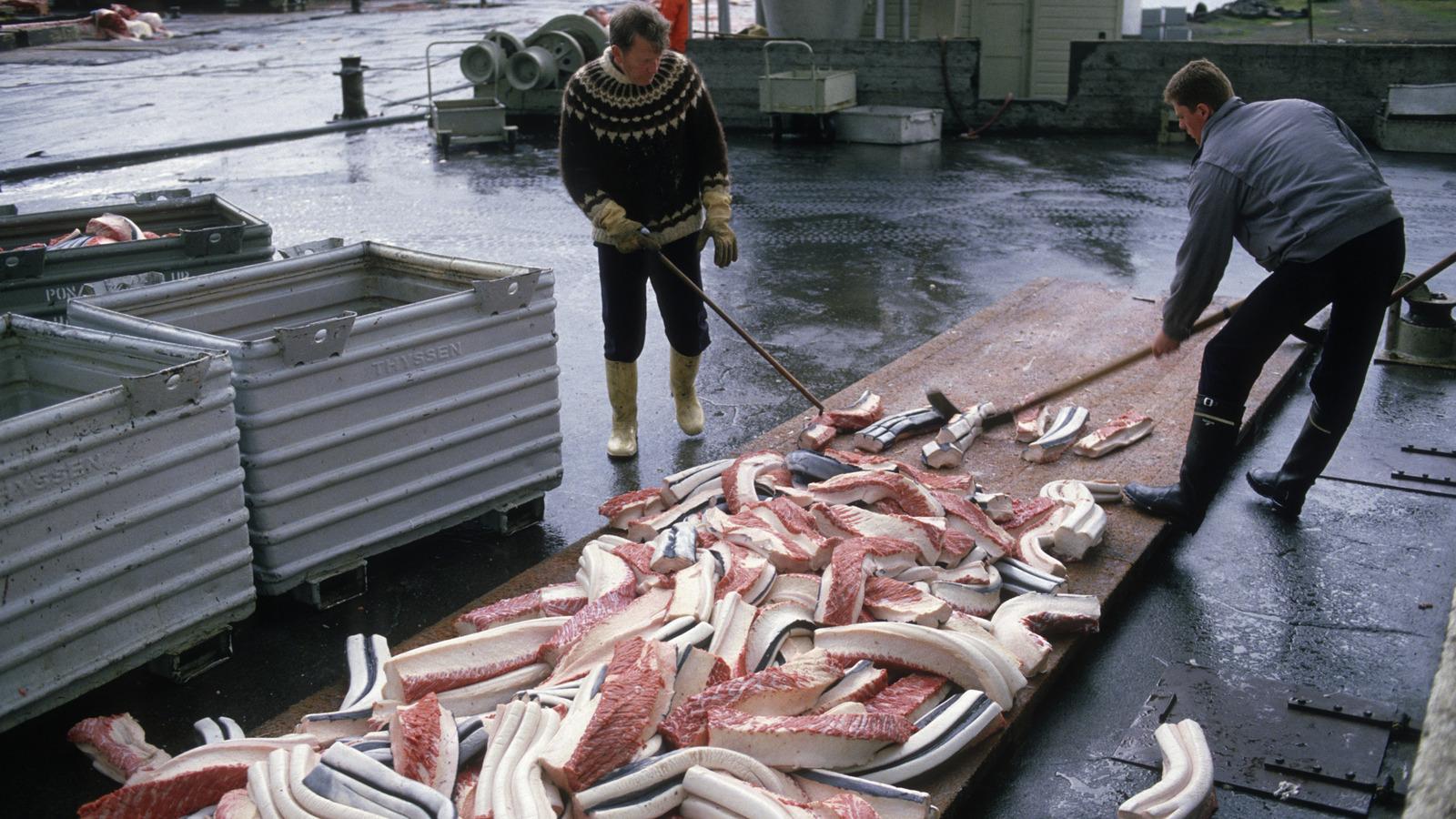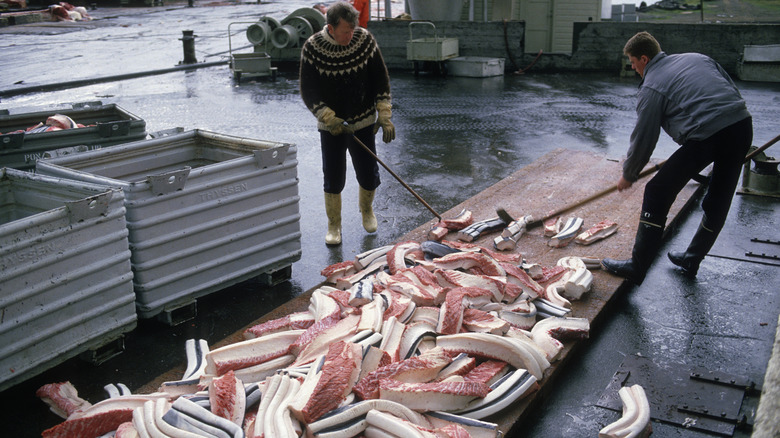
Clu/Getty Images
While you're browsing your grocery store's meat selection or making the rounds at a specialty fish market, the United States' legal system probably isn't at the forefront of your mind. Obvious or not, every retail food item in the U.S. is subjected to scrutiny from the federal government. The types of animals that are killed for food, bought, sold, and eaten must be in compliance with the nation's laws. This is a relatively new concept.
Some meats that were a reliable food source in the past are illegal to commercialize in the U.S. today. The laws and protections surrounding meat consumption have two basic intentions. One is to keep the general public from eating certain meats that could make them sick. The other is to protect our wildlife. Overhunting and overfishing has decimated the populations of many species, some to the point of near-extinction.
Lest you forget, food is political. Not everyone has taken federal meat bans quietly, leading to a necessary discourse. Meats that were banned decades ago for public health reasons may be based on outdated information. Bans on hunting sea mammals and wild game disproportionately affect America's Indigenous communities. Here are 13 meats that people used to eat that are now banned in the U.S.
1. Livestock lungs
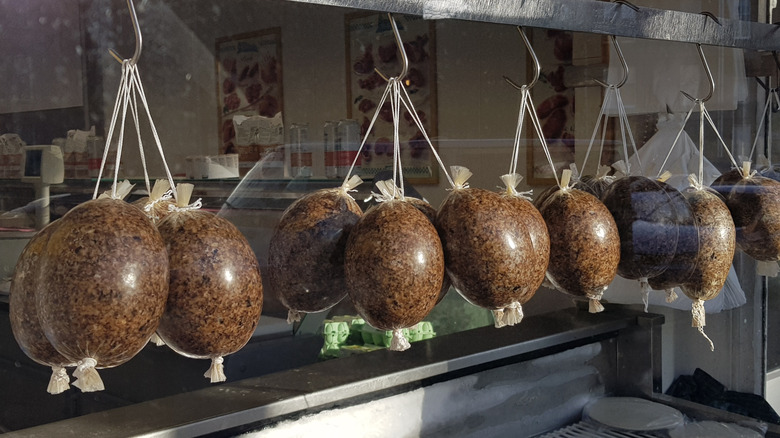
Zicc/Getty Images
Eating the organs of livestock — also known as offal — is a practice Americans tend to view as old-fashioned. While it's true that dishes like lungen stew or haggis are out of style comfort foods, these international classics are actually illegal in the U.S. because they contain livestock lungs. The federal ban on livestock lungs went into effect in 1971, when the United States Department of Agriculture (USDA) deemed them unfit for consumption.
Haggis was a major target of the ban. The centuries-old Scottish recipe of chopped sheep liver, heart, and lungs encased in sheep's stomach lining was considered a threat to public health. One rationale in banning it was that spongy lung tissue could harbor harmful microorganisms. Another was the possibility of stomach contents entering animals' lungs during slaughter, increasing the risk of disease in consumers. Recently, these long-held beliefs have been challenged by medical professionals looking to destigmatize livestock lung-eating.
Those petitioning the ban cite the fact that illness outbreaks related to eating lungs are extremely rare. Haggis is just one dish containing lungs that is still eaten elsewhere in the world. Kokoretsi is a traditional Greek dish of slow-roasted lamb or sheep intestines wrapped around lungs, livers, and kidneys, that's often eaten on Easter. A spicy Sichuan dish called Fu Qi Fei Pian, which translates to "husband and wife lung slices," is typically made with pig's lungs, but Americanized versions opt for sliced beef brisket and tripe.
2. Horse
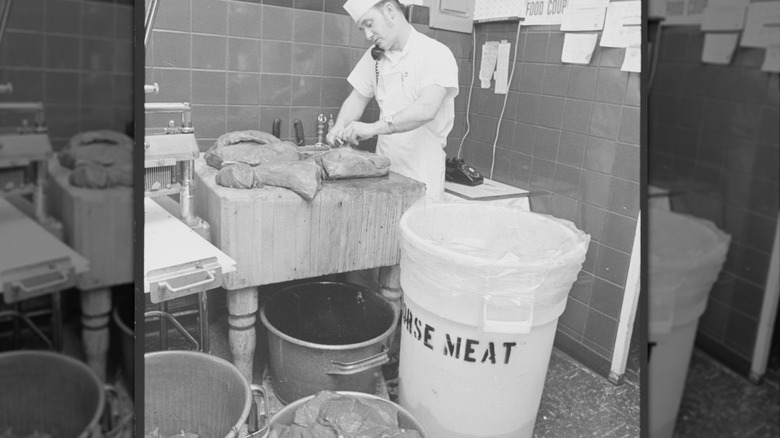
Bettmann/Getty Images
In America, horse meat is a touchy subject, but it was eaten somewhat widely throughout the Western world in the not-so-distant past. The French ate horse meat during the revolution of the late 1700s, and the practice continued in times of peace and prosperity. Some 19th century Americans also ate horse under dire circumstances, but most domestic butchers of the era either sold horse meat disguised as beef or exported it.
In the early 1900s, a spike in the U.S. population and a decrease in cattle numbers saw people embracing horse meat. The tender yet stringy game fed Americans through decades of struggle, from World War I, the Great Depression, and World War II. When World War II food rations ended, so did people's apparent enjoyment of horse. Bans on the sale of horse meat were enacted at the state level in the early 1950s. Butchers caught trying to pass off horse meat as beef faced fines or jail time.
Since then, lawmakers have loosened the horse meat selling ban during times of economic hardship, such as the recession from 1973 to 1975. In 2006, federal funding for mandatory inspections of horse meat plants was pulled, and most of the remaining plants shut down. Laws surrounding the sale of horse meat vary by state, but according to data from Animals' Angels, the number of U.S. horses shipped abroad for slaughter has decreased by 86% in 2025.
3. Eagle
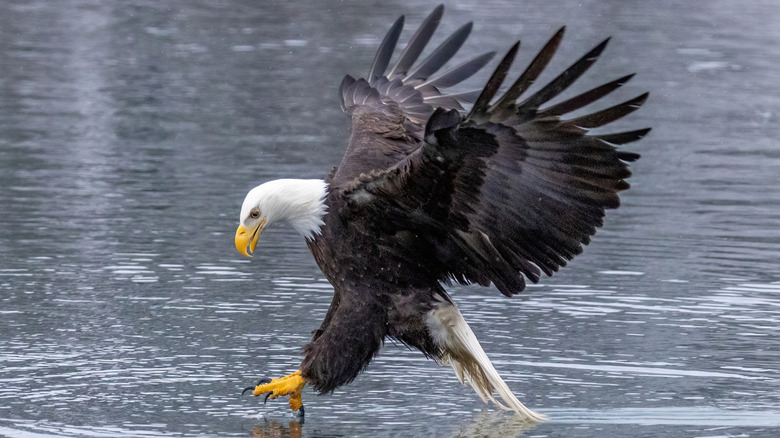
Thomas Torget/Shutterstock
If the idea of eating eagles seems cruel and unusual, consider how challenging it was to obtain food in the U.S. centuries ago. Prior to the colonization of North America, Indigenous peoples lived off the land. Not all Indigenous tribes treated eagles as a primary meat source, however, communities such as the Huron of the Great Lakes and the Kaska Dena, Kitsumkalum, Kwakiutl, Nuu-chah-nulth, and Salish of the Pacific Northwest were known to hunt eagles for food. Killing bald eagles in any capacity was outlawed in the U.S. in 1940. An amendment in 1962 was made to include golden eagles.
Under the Bald and Golden Eagle Protection Act, individuals cannot "take, possess, sell, purchase, barter, offer to sell, purchase or barter, transport, export or import, at any time or in any manner any bald eagle commonly known as the American eagle or any golden eagle, alive or dead, or any part, nest, or egg thereof," unless granted authorization by the Secretary of the Interior. There have been multiple amendments to the act over time.
One memorandum concerns the cultural significance of eagles in Indigenous communities. In 1994, the "Policy Concerning Distribution of Eagle Feathers for Native American Religious Purposes" was added. This policy implored the government to work proactively and cooperatively with tribal governments concerning the procurement of eagle carcasses, body parts, and/or feathers for religious ceremonies "to the fullest extent of the law."
4. Whale
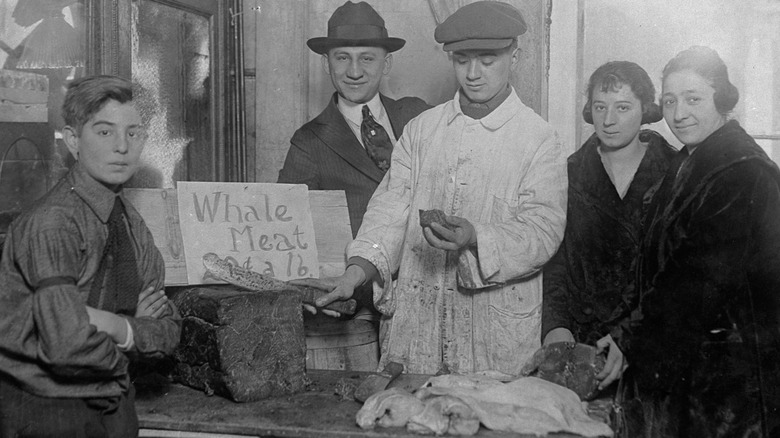
General Photographic Agency/Getty Images
Eating the meat of the great giants of the sea is an ancient practice that still resonates today, but conserving our oceans' whales is an environmental cause everyone should get behind. Commercial whaling has been banned in the U.S. since 1972, when the Marine Mammal Protection Act (MMPA) was passed by Congress. Whales received protection from the act's general provision: calling for the ban on taking any sea mammals from the water. Imports of sea mammals or products made from them is also illegal.
Another provision to the act gave Indigenous groups such as the Makah Tribe legal permission to hunt whales in small quantities over a certain period of time. In honor of the Treaty of Neah Bay of 1855, the U.S. government gave the Makah Tribe authorization to hunt whales. Under the watchful eye of the Whaling Commission, the Makah are granted a ceremonial and subsistence hunt quota of up to 25 Eastern North Pacific (ENP) gray whales over a 10 year period. The treaty was signed after the Makah ceded thousands of acres of land to the U.S. government to retain their right to go whaling in Neah Bay.
5. Ortolan
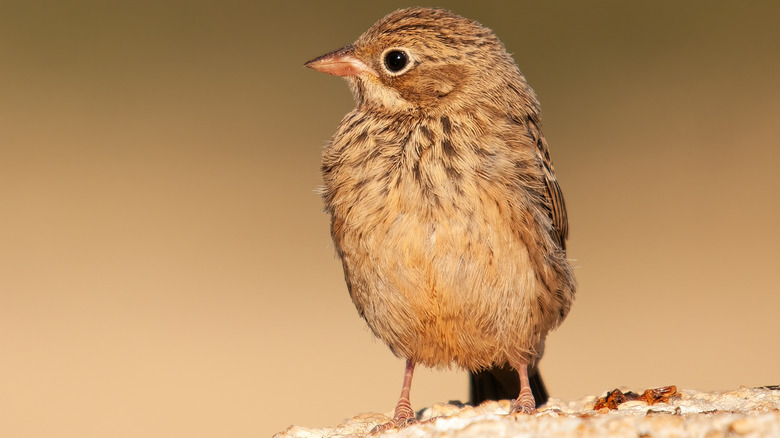
TAMER YILMAZ/Shutterstock
It's basically impossible to justify the treatment of ortolan bunting, the tiny songbird turned prized delicacy of the ostentatiously wealthy. Migratory ortolan, just over six inches in length, have been eaten since the days of Ancient Rome, yet its more recent, haute cuisine preparation is a continuous problem. Ortolan are typically captured while migrating through Southwestern France on their way to Africa. Once caught, they're force-fed before being drowned in a vat of Armagnac brandy. The European Union banned ortolan hunting in 1979, but snuffing out illegal ortolan poaching is a work in progress.
Due to their sought-after nature, (a single ortolan can cost upwards of $200 at a restaurant), an estimated 30,000 of the 300,000 ortolan migrating through France are illegally poached, causing significant decline to their population. Yet perhaps the most disturbing part of all this is how ortolan are eaten.
What you may have seen depicted in television shows like "Succession" is real. The usual way to eat a naked, roasted ortolan is with a cloth napkin over your head. Some say it's to shield your eyes from the judgmental gaze of God. Others claim it's to hide the required bone-spitting that comes with eating a bite-sized bird whole. Either way, eating ortolan is where wrong and bizarre intersect.
6. Sea otter
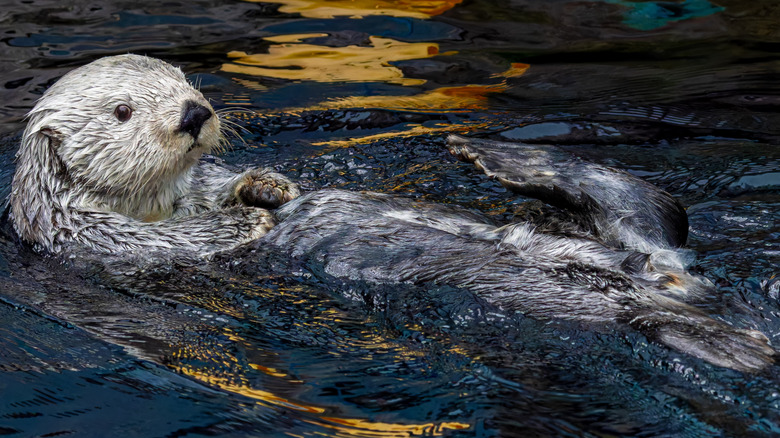
Tane-mahuta/Getty Images
The thick fur of sea otters was a prized pelt for hunters of the past, and its meat provided sustenance. The Indigenous peoples that hunted sea otters did so by steering canoes on the open waters of the Pacific Northwest. Some would boil the otter meat in soups or stews, others would prefer it grilled. Views on eating otter meat also varied. Certain Indigenous communities considered sea otter a delicacy while others only consumed it when other meat sources were in short supply.
By the 1800s, the sea otter population had dropped to worrying levels. This was primarily attributed to the growing number of European settlers in the region who shot sea otters for their valuable pelts. In 1911, when there were between 1,000 and 2,000 sea otters left in the Pacific Northwest, the U.S. signed a treaty with Russia, Japan, and Great Britain (which held legislative authority of Canada at the time) to suspend the taking of sea otters. The Endangered Species Act (ESA) listed Southern sea otters as a threatened species in 1977. They remain under threatened status to this day.
7. Puffin
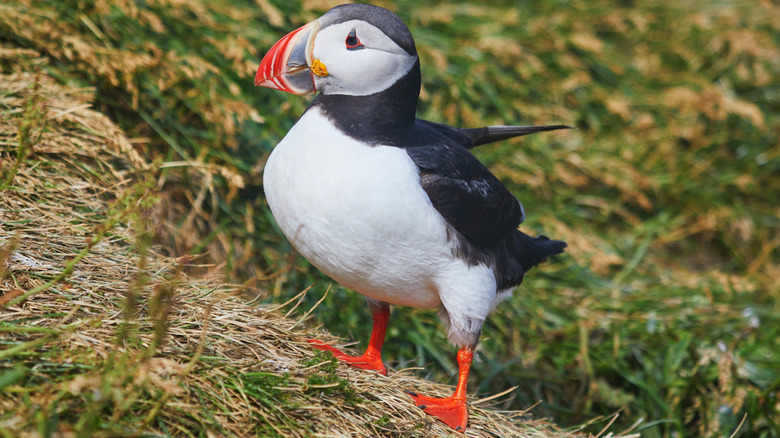
Ekaterina Pokrovsky/Shutterstock
It's hard to imagine eating a cute little puffin, but it happens. Puffins are members of the auk family that populate rocky Northern coastlines of the U.S., Canada, and Europe. Their presence in Maine was obliterated in the 19th century because of overhunting ... then the law stepped in. Hunting puffins was outlawed in the U.S. in 1916 under the Convention Between the United States and Great Britain for the Protection of Migratory Birds.
This legislation called for the cessation of hunting non-game migratory bird species, with puffins being listed among them. Provisions of the agreement stated that Indigenous Americans could continue to hunt certain non-game migratory birds (including puffins), however, selling the birds or their eggs was prohibited. The U.S. isn't the only nation to give legal leeway to the customary hunting and eating of puffins.
Iceland is one of the last places on earth where you can still order puffin at a restaurant. Smoked puffin meat is a national culinary delight, yet the inconveniences of climate change combined with overhunting and habitat destruction are causing some to rethink this age-old practice.
8. Robin
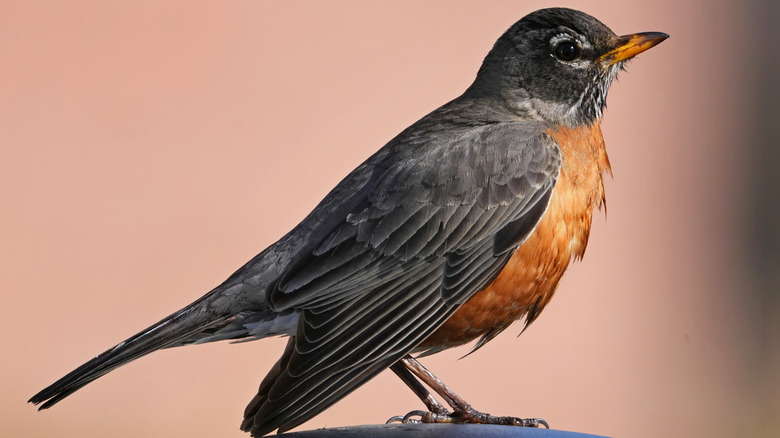
Mariusz Lopusiewicz/Shutterstock
The American robin is one of the nation's most beloved birds. It symbolizes the coming of spring, lays beautiful, bright blue eggs, and is best-recognized by its red-orange breast. Yet in America's earlier days, the migratory songbird was also a popular filling for pies. During the early 19th century, robins were commonly sold at open-air game markets. The dish "robins on toast" was a staple at many restaurants. Around the 1830s, a cultural shift regarding robin hunting caught on, laying the groundwork for its eventual illegality.
When sporting aristocrats deemed robins unsuitable for shooting, the government took interest. Suddenly, those in the lower class who still relied on robin hunting for food were frowned upon. This down-trend, which was simultaneously prejudicial to low-income communities and favorable to the U.S. robin population, was made into law. In 1899, Congress outlawed the sale of songbirds in Washington, D.C., and more protections were to come.
The Convention Between the United States and Great Britain for the Protection of Migratory Birds was signed into law on August 16, 1916. This agreement between nations called for a limited hunting season on numerous migratory birds. It also banned the killing of "migratory insectivorous birds" year-round.
9. Caviar from the Caspian Sea
Beluga caviar is synonymous with old world opulence, yet the history of beluga and other types of sturgeon caviar hold some dark undertones. Beluga sturgeon, also known as "huso huso" is the largest freshwater species that exists. These giant, ancient fish once swam abundantly in the Caspian Sea. For centuries, the Caspian waters, which border Russia, Kazakhstan, Turkmenistan, Azerbaijan, and Iran, were full of fishermen's boats eager to capture as many sturgeon as possible. Within the belly of female surgeons, were hundreds of thousands of eggs worth hundreds of thousands of dollars. Times have changed.
By the early 2000s, overfishing Caspian sturgeon was so severe, outlawing it was the only way to prevent their extinction. On September 30, 2005, the U.S. outlawed the import of any Caspian meat or caviar. Russia banned commercial beluga fishing in 2000, followed by a ban on sturgeon and sevruga fishing in 2005. The United Nations made it illegal to export beluga sturgeon caviar from the Caspian Sea in 2006. Sturgeon fishing in the Caspian Sea was banned completely in 2014.
Beluga, ossetra, and other native Caspian caviar are still sold, but all of it comes from sturgeon farms where the eggs are extracted without killing the fish. In 2019, Marky's in the U.S. received a federal exemption to sell purebred beluga caviar harvested from Sturgeon AquaFarms in Florida. The exemption was primarily due to the fact that the sturgeon were imported prior to the 2005 ban.
10. Dog

Alivia Houdek / 500px/Getty Images
Most Westerners wouldn't jump at the chance to eat dog meat, and this may have always been the case. According to historic and archaeological evidence, early-era colonists in North America ate indigenous dogs in times of extreme scarcity. Similarly, when enemy troops surrounded Paris during the Franco-Prussian War in 1870, effectively cutting off its food supply, dog, cat, and rat meat were sold publicly in the streets. No matter how tough things get in the 21st century, U.S. law prohibits killing dogs for food.
Congress passed the Dog and Cat Meat Trade Prohibition Act (DCMTPA) in 2018, protecting both domestic species from slaughter for the purpose of consumption. It's illegal for slaughterhouses in all 50 states to handle dogs, however, dog meat itself is only banned by seven states. Historical accounts from 19th century explorers note that dog meat was consumed by Indigenous peoples of the Great Plains, such as the Sioux.
In modern-day America, dogs are man's best friend. Yet nations like China and South Korea still sell and eat dog meat. Although dishes like South Korea's boshintang, or "dog meat soup" have been eaten for thousands of years, Korean animal rights protestors continuously demonstrate against dogs being slaughtered for their meat.
11. Shark fin
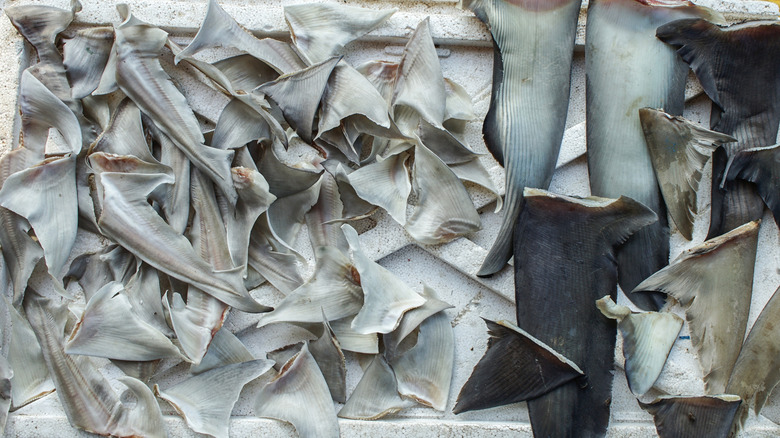
Lander Rana Jaya/Shutterstock
We've all heard of shark fin soup. The polarizing and venerable Chinese dish has origins in animal cruelty, which has inspired a shark fin ban in the U.S. The Shark Research Institute estimates that between 73 million and 100 million sharks are killed for their fins each year, and the harvesting method is inhumane. Rather than capture whole sharks, fishermen looking to cash in on the valuable fins (which fetch up to $700 per kilo) slice fins off of living sharks then toss the animals back into the water, leaving them to die on the ocean floor. The U.S. implemented a ban on shark finning in the Atlantic in 1993. It was the first country to do so.
The Shark Finning Prohibition Act of 2000 made shark finning illegal for any vessel traversing the U.S. Exclusive Economic Zone, however, killing sharks isn't outlawed at the federal level. The state of Hawaii is leading the way for shark conservation in the U.S. In 2010, Hawaii banned the private ownership of shark fins. It became the first state to enact a complete ban on shark fishing in 2022.
12. Seal

Archive Photos/Getty Images
Seals live all over coastal North America, but the time-honored tradition of eating their meat is a regional practice. Indigenous communities of the far North, including the Inuit in Nunavut, Canada and the Inuit of Alaska, have hunted seals for generations. Unlike commercial seal hunters of the past who were only interested in seal skins and abandoned carcasses after the take, Indigenous seal hunters make use of the whole animal. Seal oil is used as a topical balm, the skin provides shoes and clothing, and the meat offers sustenance, much to the chagrin of policy makers.
When Indigenous peoples eat seal, they waste nothing. The meat, blood, organs, blubber, flippers, and eyes are all consumed. Despite such mindful harvesting, hunting sea mammals is banned in the U.S. under the Marine Mammal Protection Act (MMPA) of 1972. In Canada, seals can be legally hunted by fisherman with a seal license, but only specific hunting weapons and types of seal are permitted.
Indigenous populations of the Arctic hold contentious views on banning seal meat. The USDA prohibits sea mammal meat from being served in facilities such as hospitals or nursing homes — even those situated above the Arctic Circle. For individuals from Northern Indigenous communities, admittance into these facilities means forgoing the meats they've eaten their entire lives.
13. Goliath grouper
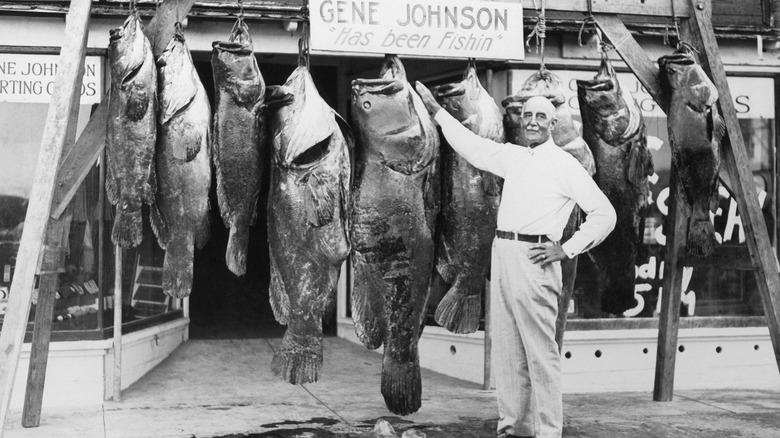
Igfa/Getty Images
It was once an astounding stroke of pride to catch a magnificent goliath grouper, but those days are over. Harvesting these deep-sea gentle giants, which inhabit the waters of the Southeastern U.S., was banned in the early 1990s. The decision was enacted by the National Oceanic and Atmospheric Administration (NOAA), a cabinet within the U.S. Department of Commerce that monitors marine life. Action was taken when the goliath grouper became so overfished, it was on the verge of being listed as an endangered species.
In 2022, the goliath grouper population had recovered enough that a highly limited harvest season was opened in designated regions of Florida. From March 1 to May 31 annually, 200 permits are given, allowing for goliath grouper between 24 and 36 inches to be caught by hook-and-line fishing only. Goliath grouper are still classified as a Species of Concern by the U.S. Fish and Wildlife Service, and eating them probably isn't a great idea anyway.
Unlike the quirky old-fashioned seafood dishes that deserve a comeback, feasting on goliath grouper is best left in the past. It's a massive fish — reaching over 8 feet in length and weighing around 800 pounds. The larger the fish, the more methylmercury is retained in its body. The Environmental Protection Agency (EPA) warns against consuming fish with a methylmercury content above 0.3 parts per million (ppm). Concentrations of methylmercury in a mature goliath grouper can be as high as 4.5 ppm.



